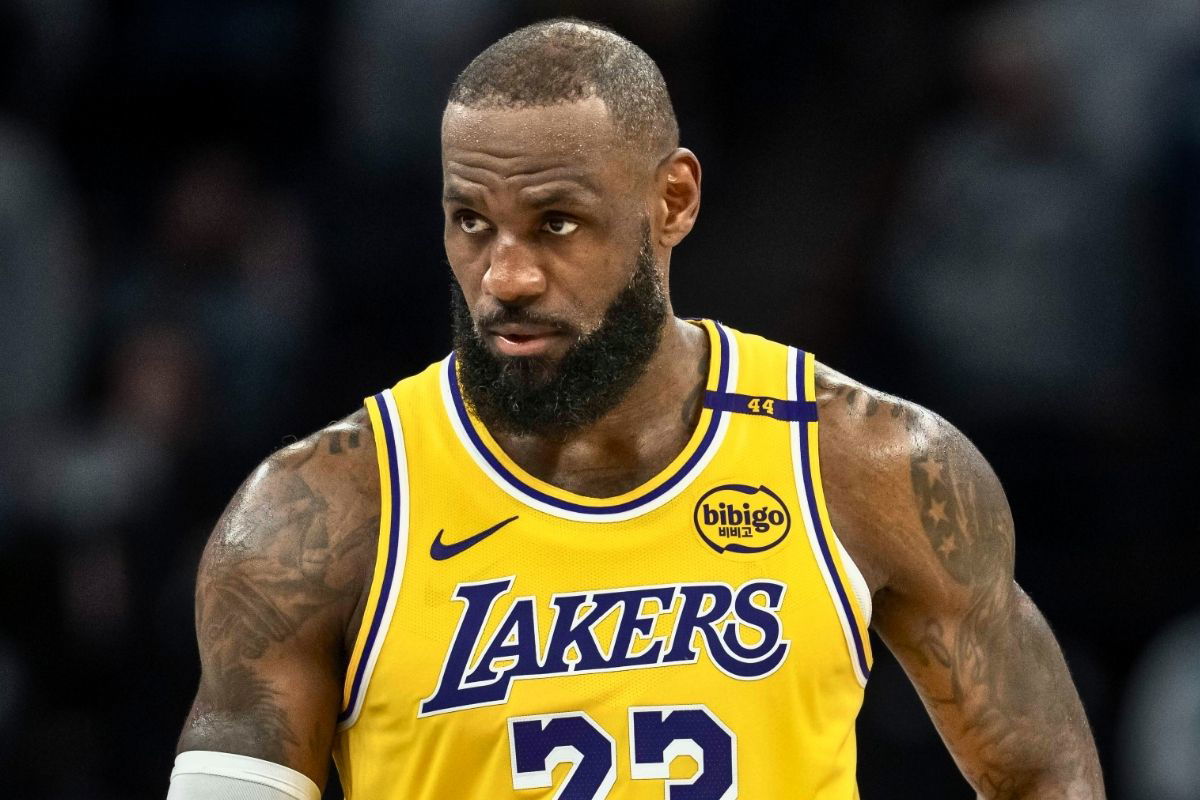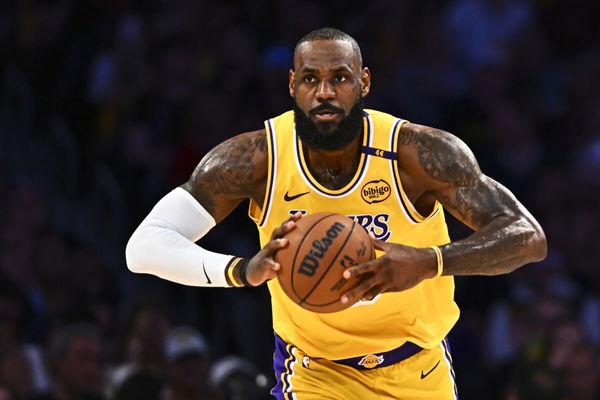
Imago
Apr 25, 2025; Minneapolis, Minnesota, USA; Los Angeles Lakers forward LeBron James (23) looks on against the Minnesota Timberwolves in the second half during game three of first round for the 2024 NBA Playoffs at Target Center. Mandatory Credit: Jesse Johnson-Imagn Images

Imago
Apr 25, 2025; Minneapolis, Minnesota, USA; Los Angeles Lakers forward LeBron James (23) looks on against the Minnesota Timberwolves in the second half during game three of first round for the 2024 NBA Playoffs at Target Center. Mandatory Credit: Jesse Johnson-Imagn Images
LeBron James hasn’t missed a season opener since the beginning of his 23-year-long NBA career. He has led the NBA in minutes, logging 59,041, outlasting rivals and even memes about his longevity. But now, the game’s ultimate constant faces something he has never had to deal with before, which is watching the season begin from the sideline. The Lakers announced that the 40-year-old will sit out for at least three weeks because of right-side sciatica, keeping him sidelined for the October 21 tip-off and sparking a big question about whether this is really about basketball or if it started on the golf course.
Watch What’s Trending Now!
ESPN’s Brian Windhorst addressed the suspicions head-on, speaking on NBA Today. “Let me deal with the elephant in the room because I know I got a lot of text messages about this,” he said. “People were asking me, ‘Was this a golf-related injury?’ Because LeBron played golf all summer. And sciatica is something that happens to golfers.” He explained that for a right-handed golfer, pain usually flares on the left side, not the right, as in LeBron’s case, which made it clear this wasn’t about tee time. Instead, Windhorst said, “This is an injury that is related to basketball.”
That line cut through the rumors, but it also exposed something else.
ADVERTISEMENT
While LeBron James has been remarkably durable throughout his two-decade career, even he isn’t immune to the wear and tear that comes with longevity. The incident in Game 5 against the Timberwolves, when James collided with Donte DiVincenzo and suffered a Grade 2 MCL sprain in his left knee, served as a rare reminder of his mortality. On his Mind the Game podcast, LeBron reflected on the setback:
“In my 22-year career, this is my first knee injury. I’ve had regular tendonitis, patella, all that stuff — but this is the first time I’ve had a sustained knee injury where you gotta get off your feet. You gotta be shelved for a minute.”
It marked an unusual moment in James’ storied career- not just because of the knee issue itself, but because it coincides with a growing concern surrounding his sciatica, initially described as a “glute irritation” but now reportedly severe enough to impact mobility and recovery rhythm.
ADVERTISEMENT
For a player whose game has long defied time through conditioning and biomechanics, this stretch represents uncharted territory- both physically and mentally- as he navigates the most sustained injury challenge of his career.
His offseason, instead of being a typical grind, turned into rehab and maintenance. Then came the long golf stretch with plenty of rotation, no contact, and far less conditioning than a player used to living at playoff tempo. Add 22 seasons’ worth of torque, and suddenly, the body sends a reminder that not even LeBron’s recovery rate is immortal.
ADVERTISEMENT
Windhorst also revealed that LeBron has dealt with back issues throughout his career, including receiving epidural shots to manage lower back inflammation. The good news? “He has always recovered very well from them,” Windhorst said. The caution, though? The Lakers know that back injuries can be deceptive. They stick around, and if mishandled, derail entire playoff runs. So, the team’s response has been deliberate.
A three-to-four-week shutdown period means no training camp reps or preseason games for the foreseeable future, and no immediate chemistry with fresh faces like Deandre Ayton and Marcus Smart. Head coach JJ Redick emphasized a slow build-up, signaling that the Lakers are playing the long game, which, well, is a phrase that now defines the LeBron era as much as his stat sheet. The optics, though, are unavoidable.

Imago
Apr 27, 2025; Minneapolis, Minnesota, USA; Los Angeles Lakers forward LeBron James (23) talks with his coach during a stoppage in play against the Minnesota Timberwolves in the second quarter during game four of first round for the 2025 NBA Playoffs at Target Center. Mandatory Credit: Matt Blewett-Imagn Images
LeBron spent much of the summer embracing his golf persona. The Instagram clips and the “LeGolf James” tags all became part of his offseason identity. So when the word sciatica hit the injury report, the connection practically wrote itself for fans.
ADVERTISEMENT
What LeBron James’ sciatica injury really means
Sciatica is not a filler word tossed into an injury update. It’s nerve pain that radiates from the lower back through the glutes and legs, often tied to disc pressure or inflammation. For athletes, especially those with explosive movement patterns like LeBron, it’s a ticking clock.
ADVERTISEMENT
Age compounds it. Every pivot or torque has a little more consequence than it did five years ago. In LeBron’s case, the Lakers’ cautious approach makes sense.
Take rest, physical therapy, anti-inflammatories, and possibly more injections. But the goal is to make sure this flare-up doesn’t become chronic. Most NBA players with conservative treatment return within a month, but for someone with over two decades of mileage, every recovery takes a little longer. History offers lessons in itself, too.

Imago
Apr 11, 2025; Los Angeles, California, USA; Los Angeles Lakers forward LeBron James (23) passes against the Houston Rockets during the first half at Crypto.com Arena. Mandatory Credit: Jonathan Hui-Imagn Images
Dwight Howard’s back issues started small and escalated with a need for a microdiscectomy. Michael Porter Jr. needed multiple surgeries before stabilizing. Kawhi Leonard still manages recurring nerve pain.
Each case reminds us how fine the line is between temporary and career-altering. LeBron’s sciatica, though, likely stems from the accumulation of motion and stress rather than one moment.
It’s why the Lakers’ medical team is pacing his return. No one in the organization wants to risk a short-term fix that leads to a long-term setback. Especially not when their season’s ceiling still revolves around him.
What LeBron James’ absence means for the Lakers
The Lakers are built around LeBron’s influential pull. Every offensive scheme bends around his decision-making, as every defensive rotation adjusts to his presence. Without him, the system looks different, and not necessarily worse, but uncertain. Redick now faces an early chemistry test with Ayton, Smart, and Luka Doncic all expected to shoulder heavier loads.
Training camp was supposed to be Redick’s space, the place where his offense took shape. Instead, he’s without his most important variable. “No one has got any time with LeBron,” he reportedly told staff. That absence hits leadership and strategy all at once. There’s also the bigger picture of LeBron’s current deal, which runs through the 2026 season, with a player option for the final year.
Each injury brings fresh questions about how much longer the Lakers can structure their roster around him. Financially, he’s the leader. Emotionally, he’s the heartbeat. But at 40, even the heartbeat needs maintenance, right? If all goes as planned, he’ll return by early November. If not, expect minute restrictions and scheduled rest days to become routine.
The Lakers are prioritizing spring over fall. They need LeBron healthy for April, not dominant in October. Fans predictably split into camps. But most understand that this is the trade-off for longevity. So as the season tips off without him, the question isn’t just when he returns, but what he’ll look like when he does.
Will we see another comeback stretch and reminder that LeBron’s timeline still breaks the rules? Or is this the first real signal that even the King’s clock is starting to tick louder?
ADVERTISEMENT
ADVERTISEMENT
ADVERTISEMENT

